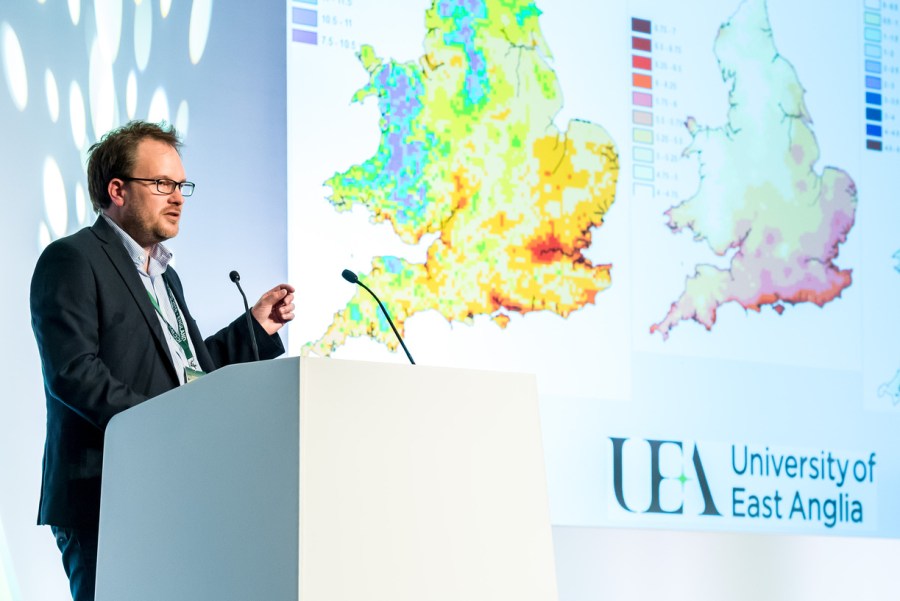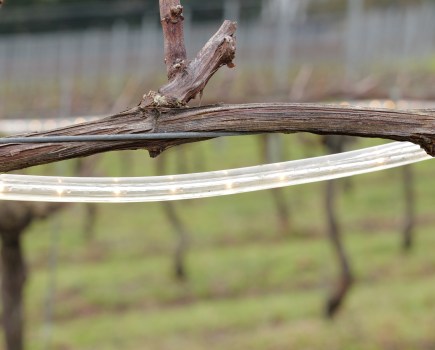Great Britain is an island of weather with many different and competing patterns – and to top that we are now dealing with climate change. Dr Alistair Nesbitt is a Viticulture Climatologist with significant expertise in how weather and climate interface with wine production. He is based in the UK but advises globally and holds the UK’s first PhD in Viticulture and Climate Science. Vineyard asks Alistair what the likely changes to our growing conditions will be, which opportunities and threats face our industry – and how producers can become more resilient to the changes of the future.
Dr Alistair Nesbitt has always held an interest in viticulture and the environment. “I remember my first harvest in Australia in 1999 when hail had ruined most of the crop – it was depressing stuff but that sparked my interest in weather and wine. I returned to the UK and completed a BSc in Viticulture & Oenology at Plumpton College, then a Masters in Wine Science and as I enjoyed academic work and research, I decided to challenge myself with a PhD. I actually wrote down my ideal PhD title – the impact of climate change on viticulture. Shortly after, rather bizarrely, my perfect PhD appeared on the ‘Find a PhD’ website. It was posted by Professor Steve Dorling a meteorologist and climatologist at the University of East Anglia (UEA). So, 15-years after that hail damaged harvest in Australia, I began my PhD research, supported by a scholarship from the Natural Environment Research Council.”
Ideal UK weather conditions for viticulture in 2018 led to a record harvest, but could this be a sign of good thigs to come? “Long-term Growing Season Average Temperatures (GSTs) in south-east and south-central England have noticeably increased with six of the top 10 warmest growing seasons over the last 100 years, occurring since 2005. However, weather and growing season conditions fluctuate markedly from year to year, meaning that yields and grape quality continue to vary significantly. As weather extremes are anticipated to become more frequent under future climate change these could further threaten the stability of production in the UK,” explained Alistair.
Alistair’s research has resulted in numerous published papers, but his main current research project is focussed on climate resilience in the UK wine sector – called CREWS-UK. “The project is a collaboration between climatologists, wine sector specialists and social scientists from the Grantham Research Institute and the University of East Anglia. It will provide information on how climate change will affect the wine production sector to inform better decision-making, investment and adaptation,” explained Alistair.
“It will do this by firstly mapping and analysing climate trends and impacts on UK grape growing and assessing ways to support climate change adaptation in UK wine production. The project outcomes will be published in about six months’ time, which will provide user-friendly information on anticipated climate changes in order to help the industry plan for a resilient future,” he commented.
According to Alistair, current Met-Office general projections for the UK are for hotter drier summers, along with warmer, but wetter winters – but that some parts of the UK are likely to experience greater extremes of weather with high rainfall intensity, heat waves and drought events. “This will result in variability within seasons and from one season to the next. Although the UK already experiences seasonal variations, this will increase for some areas. The CREWS-UK research project will provide the detail that is relevant to viticulture and wine production to help producers adapt and build resilience – for example improve yield consistency,” added Alistair.
“We need to look to the future, as the varieties, clones and rootstocks that are suitable now, may not be ideal in 20 to 30 years’ time when conditions change. For example, the open structured bunches of the German clones may be more suitable than the tighter Champagne clones, and certain rootstocks are more drought resistant than others. We need to look at opportunities also as the warmer growing season temperatures may favour varieties for still wines such as Sauvignon Blanc, as well as Pinot Gris and Pinot Noir.”
Some of Alistair’s previous published research shows that although there appears to be many suitable sites for viticulture in the UK, many vineyards are established in sub-optimal locations. “Going forward site selection will need to focus even more on those areas of the UK that are more climatically stable year on year, those that will have a higher frequency of good years, which also means more stability from a commercial point of view. Already, some areas of the UK are being recognised as having untapped potential, one of these being parts of southern Essex ,” added Alistair. Producers need to look at future climate models – what growing conditions and soil conditions will likely be like in 20 or 30 years’ time – selecting those that will be more favourable in the future, and not necessarily the most suitable now,” he added.
Why is the climate changing?
“There is no longer the balance in the climate system that there used to be – the climate has been knocked off course,” explained Alistair. “The heat accumulation in the atmosphere is due to greenhouse gas emissions, the warming atmosphere is causing ice melting and the oceans to warm – and causing the balance in the climate systems to change. Coincidentally, these are the conditions that have underpinned the expansion of viticulture in the UK.”
Are frosts the new norm?
Over the past few years, there have been several springs with long periods of high pressure, explained Alistair. “This results in an earlier bud-burst, due to increased daytime temperatures, but high pressure also brings ideal conditions for radiative frosts – so a perfect storm for viticulture – early bud-burst and late spring frosts. However, as yet there is no evidence to show that this is the new norm, but climate researchers are looking into this at UEA. In my view, an established vineyard in the UK should plan and budget for frost events unless they are in a very low risk area, such as close proximity to the coast. Not only do late spring frost events cause significant crop losses, they can also set the vineyard back more than just a year.”
More resilience
There are several areas which Alistair advises producers to be aware of regarding climate change. “Accept variability in yield and build this into the business model – for example, mitigate against variable volumes by holding reserve wines from higher volume years.”
“It is going to be increasingly important to have a skilled workforce. Vineyard Managers and Winemakers need to have the knowledge and experience to be able to anticipate and adapt to differing seasons and conditions, some of which will be beyond ‘normal’ – in both the vineyard and winery,” he added.
Site selection is not just choosing the right vineyard sites for now, explains Alistair, “but selecting suitable sites in areas that are more climatically stable – so that yield variations are not as extreme, and businesses are more secure. Soil management will become increasingly important – as sink for carbon – that is also able to retain nutrients and hold moisture in drier years. Vineyards can also select varieties and rootstocks that are better able to withstand drought, that are flexible and can perform well in both warmer and cooler conditions.
“Good planning will ensure that you have the equipment and resources to manage extreme weather conditions, especially frost. As well as the skilled workforce that can focus on cultural techniques to help mitigate risks – such as selecting sacrificial canes and opting to prune later,” said Alistair.
Although a long way off, Alistair says that growers will need to be aware of the risks of drought and sunburn damage. “We may, over time need to look to other areas for viticultural techniques, such as shading and irrigation, such as central Australia.
“We will see diseases here that are currently prevalent in warmer climates and this will again require a skilled viticulturist to manage them – along with suitable varieties that are more resistant, maybe the PIWIS, and appropriate plant protection products.
“For climate resilience we need to have flexibility and be able to adapt our growing practices to changing conditions. We must avoid limitations and restrictions imposed by ‘red tape’ and excessive regulations. Look at how parts of Bordeaux have recently had to peel back regulations in order to approve new varieties that would be better suited to their changing conditions.
Opportunities, challenges and threats
It’s crucial that new entrants and existing vineyards understand our changing climate, explains Alistair. “As well as a good site, businesses need to map out a credible route to market from the very start. There are lots of viticultural opportunities in the UK, and the sector is growing fast – but sales must match this growth.
“As the climate changes, with warmer growing seasons and better ripening conditions, there is an increasing opportunity for businesses to diversify away from English sparkling wine to produce still reds, white, rosés and other innovative products that will help their cash flow and allow a range of products placed at different price points. There are already plantings of Sauvignon Blanc and still Pinot clones in areas of the UK – could these move us more toward New Zealand’s wine styles than Champagne?” Asked Alistair.
Alistair lectures internationally on viticulture and provides advice to new vineyards, governments and the global wine industry. He is the founder of Vinescapes which helps UK wine production businesses establish and operate sustainably. “Our research is being recognised at government level with its interest in the changing rural landscape, rural employment as well the importance of the landscape for health and wellbeing. The recent South Downs National Park study showed the opportunities for viticulture in a protected landscape and how valuable destinations can be incorporated in the future,” added Alistair.




